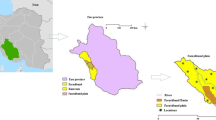Abstract
A study was undertaken to assess the quality of groundwaters in the Kathmandu Valley, Nepal. The groundwater samples were randomly collected from shallow well, tube well, and deep-tube wells located at different places of Kathmandu, Lalitpur, and Bhaktapur districts in the Kathmandu valley. Physical, chemical, and microbiological parameters of the samples were evaluated to estimate the groundwater quality for drinking water. It was found that the groundwater in the valley is vulnerable to drink due to presence of iron and coliform bacteria. Iron was estimated to be much higher then the acceptable limit of World Health Organization (WHO) drinking-water quality guidelines (1.9 mg/L). Total coliform bacteria enumerated in groundwaters significantly exceeded the drinking-water quality standard and observed maximum coliform (267 CFU/100 mL) in shallow wells. The electrical conductivity and turbidity were found to be 875 μS/cm and 55 NTU, respectively, which are above the WHO recommendations for drinking water guidelines. However, pH value was measured within the acceptable limit. Arsenic, chloride, fluoride, and hardness concentrations were found to be in agreement with the recommendations of WHO drinking-water quality guidelines.
Similar content being viewed by others
Explore related subjects
Discover the latest articles and news from researchers in related subjects, suggested using machine learning.References
CDPHE (2009). http://www.cdphe.state.co.us/lr/Water/IronSulphurBacteria.pdf. Accessed 31 October 2009.
Central Bureau of Statistics (2001). Statistical year book-Nepal. Nepal Government: National Planning Commission Secretariat.
Crichton, R. R. (1991). Inorganic biochemistry of iron metabolism. Chichester: Ellis Harwood.
Dechesne, M., Barraud, S., & Bardin, J. P. (2004). Indicators for hydraulic pollution retention assessment of stormwater infiltration basins. Journal of Environmental Management, 71(4), 371–380.
Dill, H. G., Kharel, B. D., Singh, V. K., Piya, B., Busch, K., & Geyh, M. (2001). Sedimentology and paleogeographic evolution of the intermontane Kathmandu basin, Nepal, during the Pliocene and Quaternary. Journal of Asian Earth Science, 19(6), 777–804.
Dzwairo, B., Hoko, Z., Love, D., & Guzha, E. (2006). Assessment of the impacts of pit latrines on groundwater quality in rural areas: A case study from Marondera district, Zimbabwe. Physics and Chemistry of the Earth, 31(15–16), 779–788.
Greenberg, A. F., Clescerl, L. S., & Eaton, A. D. (1992). Standard methods for the examination of water and wastewater. Washington DC: American Public Health Association.
Gurzau, E. S., Neagu, C., & Gurzau, A. E. (2003). Essential metals-case study on iron. Ecotoxicology and Environmental Safety, 56(1), 190–200.
Hem, J. D. (1992). Study and interpretation of the chemical characteristics of natural water. Washington DC: U.S. Gov. Print Office.
Houben, G. J. (2003a). Iron oxide in wells part 1, Genesis, mineralogy and geochemistry. Applied Geochemistry, 18, 927–939.
Houben, G. J. (2003b). Iron oxide incrustation in wells part 2, Chemical dissolution and modeling. Applied Geochemistry, 18, 941–954.
Jeong, C. H. (2001). Effect of land use and urbanization on hydrochemistry and contamination of groundwater from Taejon area, Korea. Journal of Hydrology, 253(1), 194–210.
Khadka, M. S. (1993). The groundwater quality situation in alluvial aquifers of the Kathmandu Valley, Nepal. Journal of Australian Geology & Geophysics, 14, 207–211.
Komnitsas, K., Bartzas, G., Paspaliaris, I. (2004). Efficiency of limestone and red mud barriers: Laboratory column studies. Mineral Engineering, 17, 183–194.
Kontari, N. (1988). Groundwater, iron and manganese: An unwelcome trio. Water Engineering and Management, 135(2), 25–26.
Krapac, I. G., Dey, W. S., Roy, W. R., Smyth, C. A., Storment, E., Sargent, S. L., et al. (2002). Impacts of swine manure pits on groundwater quality. Environmental Pollution, 120, 475–492.
Luna, L. C., & Melian, M. G. (2003). Fluoride in drinking water in Cuba and its association with geological and geographical variables. Revista Panamericana de Salud Pública, 14, 341–349.
Metcalf and Eddy, Inc. (2000). Paper presented at a seminar on groundwater and wastewater, Melamchi water supply development board. Kathmandu: Nepal.
MOPPW (2003). Optimizing water use in Kathmandu valley report. HMG/Nepal: Ministry of Physical Planning and Works.
National water quality management strategy (1996). Australian drinking water guidelines. National health and medical research council, Agriculture and resource management council of Australia and New Zealand.
NWSC (1992). Greater Kathmandu water supply project report. Nepal Water Supply Corporation.
Ritzi, R. W., Wright, S. L., Mann, B., & Chen, M. (1993). Analysis of temporal variability in hydro-geochemical data used for multivariate analysis. Groundwater, 31(2), 221–229.
Rivett, M. O., Petts, J., Butler, B., & Martin, I. (2002). Remediation of contaminated land and groundwater: Experience in England and Wales. Journal of Environmental Management, 65(3), 251–268.
Robertson, W. D., Cherry, J. A., & Sudicky, E. A. (1991). Ground-water contamination from two small septic systems on sand aquifers. Ground Water, 29(1), 82–92.
Sawyer, C. N., McCarty, P. L., & Parkin, G. F. (2003). Chemistry for environmental engineering and science. New York: McGraw–Hill.
Sharma, C. K. (1997). Urban air quality of Kathmandu Valley “Kingdom of Nepal”. Atmospheric Environment, 31(17), 2877–2883.
SOE (2001). United Nations environment program in collaboration with MOPE/HMG N, SACEP, ICIMOD, NORAD, ISBN 92-807-2012-0. Nepal: State of the Environment.
Stanley, I., & Macdonald, M. (1994). Bagmati basin water management strategy and investment program report. Kathmandu: East Consult.
Author information
Authors and Affiliations
Corresponding author
Rights and permissions
About this article
Cite this article
Pant, B.R. Ground water quality in the Kathmandu valley of Nepal. Environ Monit Assess 178, 477–485 (2011). https://doi.org/10.1007/s10661-010-1706-y
Received:
Accepted:
Published:
Issue Date:
DOI: https://doi.org/10.1007/s10661-010-1706-y




